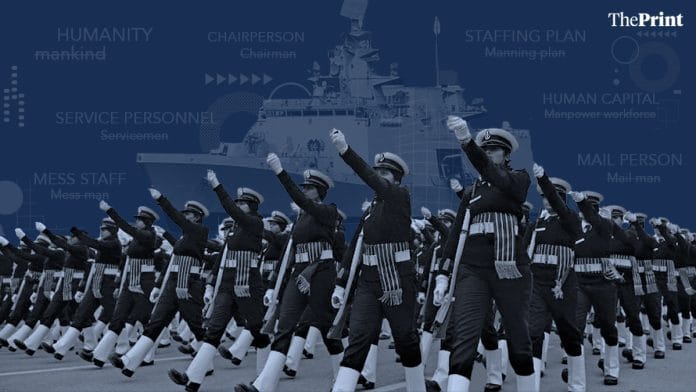New Delhi: The Indian Navy is in the process of making the language used in the day-to-day functioning of the force more gender neutral, ThePrint has learnt.
For instance, ‘mankind’ would be replaced with ‘humanity’. The force has compiled an extensive list of terms for revision. A source said that the idea is to discontinue “gender-privileged terminologies for the Indian Navy’s official communication”.
Other examples include, ‘human capital’ instead of ‘manpower workforce’, ‘chairman’ to ‘chairperson’, ‘manning plan’ to ‘staffing plan’, ‘mess man’ to ‘mess staff’, ‘mail man’ to ‘mail person’ and ‘servicemen’ to ‘service personnel’.
The use of passive/imperative statements would also come into play. For instance, a sentence such as, “Every officer must complete his incoming formalities” would be replaced by “Incoming formalities are to be completed by all officers”.
Moreover, the Navy is also looking to make certain changes to the uniforms that are worn by women onboard ships. These will cater to gender-specific requirements for both men and women for ease and comfort in carrying out operations at sea.
With the induction of women in all branches of the Indian Navy, both as officers and Agniveers, the force wants to introduce gender neutral language and avoid word choices which may be interpreted as “biased, discriminatory or demeaning”, said the source while speaking to ThePrint.
One of the major changes that the Indian Navy has undertaken is separate accommodation designs onboard all new ships, a process that was started nearly a decade ago.
This includes INS Vikrant, Visakhapatnam class and Kolkata class ships. This would continue to be implemented onboard other future projects under construction. INS Imphal, commissioned in December last year, has separate accommodations for male and female personnel. The warship, constructed in India, can accommodate as many as 20 women.
The Navy has also made available crèche facilities at most naval stations to offer daycare services for the children of its personnel. The air force, too, has started the process of having crèches at all its stations across the country.
The Navy currently has 836 women officers, 12 women sailors and 1,328 women Agniveers.
The Navy has also introduced family support measures, wherein maternity leave and child adoption leave provisions, as per the Government of India (GoI), directives have been implemented.
Moreover, a policy on ‘spouse co-location’ has been promulgated to facilitate family support.
All the three services, in accordance with GoI guidelines, are following provisions for women in all ranks for maternity leave, child care leave, child adoption leave and special maternity leave in case of death of a child soon after birth or in case of stillbirth.
Indian Air Force
The IAF, too, has introduced certain changes in day-to-day operations for women. This includes the creation of separate billets which are adequately screened to protect privacy. The billets have adequate security, changing room, modified toilets, sanitary napkin dispensers, and CCTV coverage.
Moreover, the air force has also ensured separate changing rooms for women officers in flying squadrons. Adequate numbers of washrooms near workplaces for women employees have been ensured.
While there is no change in the uniforms and dresses between male and female counterparts, the IAF has authorised certain dresses during the pre- and post-natal stage for women, where they are allowed to wear saree. In addition, saree has also been extended to lady medical officers as an option while working in hospitals, station medical centre (SMC) and medical inspection (MI) rooms.
Agniveervayu women wear ankle-length leggings and camisoles in place of briefs and vests worn by men.
In the air force, a total of 34 serving women officers have undergone Staff College Courses and eight women officers have undergone Higher Command Course.
The Indian Army
After obtaining government sanction for inducting women into personnel below officer ranks (PBOR) into the Corps of Military Police (CMP) in 2019, the 100 women were recruited and, post successful completion of training, were attested at CMP Centre and School in May 2021.
They were then posted to various units in forward and peace areas. Moreover, after the Agnipath scheme was launched in 2022, the first batch of Agniveer women military police personnel, comprising 100 women, were attested in October 2023 and posted in various units in peace and forward stations.
After women started coming in, sources in the army said that the “working culture, including administration, is undergoing a change to accommodate young women soldiers into the Corps”.
The induction of women was envisaged as a force multiplier, the source said.
The Indian Army started inducting women as officers in 1992.
The Army is focused on providing women soldiers a “safe environment to function in units”.
Army chief General Upendra Dwivedi had recently said at a seminar that the force was now trying to “harmonise physical tests based on the physiological conditions while ensuring commonality of tests with varying degree of grades”.
He added that the Army was also working towards converting the “gender equality” approach to a “gender neutrality” approach in field conditions. He further said that the Army was examining Vishakha Guidelines to protect interest of both the genders.
Also read: ‘Broad consensus’ achieved along LAC through dialogue, Rajnath Singh says day after Modi-Xi meet






